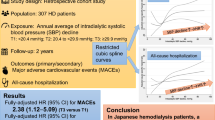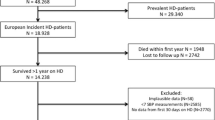Abstract
Intradialytic hypotension and intradialytic hypertension are complications of hemodialysis (HD) associated with a higher risk of cardiovascular disease (CVD) and death. Blood pressure (BP) normally fluctuates in a circadian pattern, but whether the risk of intradialytic hypotension and intradialytic hypertension varies according to the time of the HD session is unknown. We analyzed two cohorts of thrice-weekly maintenance HD (N = 1838 patients/n = 64,503 sessions from the Hemodialysis [HEMO] Study, and N = 3302 patients/n = 33,590 sessions from Satellite Healthcare). Random effects logistic regression models examined the association of HD start time (at or before 9:00 a.m. [early AM], between 9:01 a.m. and 12:00 p.m. [late AM], and at or after 12:01 p.m. [PM]) with intradialytic hypotension (defined as nadir intra-HD systolic BP (SBP) < 90 mmHg if pre-HD SBP < 160 mmHg, or <100 mmHg if pre-HD SBP ≥ 160 mmHg) and intradialytic hypertension (SBP increase ≥ 10 mmHg from pre-HD to post-HD). Compared to early AM, late AM and PM were associated with an 8% (aOR 0.92, 95% CI 0.83–1.02) and a 16% (aOR 0.84, 95% CI 0.75–0.95) lower risk of intradialytic hypotension in HEMO, respectively. Conversely, compared to early AM, a monotonic higher risk of intradialytic hypertension was observed for late AM (aOR 1.23, 95% CI 1.12–1.35) and PM (aOR 1.41, 95% CI 1.27–1.56) in HEMO. These findings were consistent in Satellite. In two large cohorts of maintenance HD, we observed a monotonic lower risk of intradialytic hypotension and a monotonic higher risk of intradialytic hypertension with later dialysis start times. Whether HD treatment allocation to certain times of the day in hypotensive-prone or hypertensive-prone patients improves outcomes deserves further investigation.

This is a preview of subscription content, access via your institution
Access options
Subscribe to this journal
Receive 12 digital issues and online access to articles
$119.00 per year
only $9.92 per issue
Buy this article
- Purchase on Springer Link
- Instant access to full article PDF
Prices may be subject to local taxes which are calculated during checkout




Similar content being viewed by others
Data availability
Data from HEMO were obtained from the National Institute of Diabetic and Digestive and Kidney Diseases (NIDDK) data repository. Anonymized data were provided by Satellite Healthcare.
References
United States Renal Data System. 2022 USRDS annual data report: epidemiology of kidney disease in the United States. Bethesda, MD: National Institutes of Health, National Institute of Diabetes and Digestive and Kidney Diseases; 2022.
Kramer A, Pippias M, Noordzij M, Stel VS, Afentakis N, Ambühl PM, et al. The European Renal Association—European Dialysis and Transplant Association (ERA-EDTA) Registry Annual Report 2015: a summary. Clin Kidney J. 2018;11:108–22.
National Kidney Foundation. KDOQI clinical practice guideline for hemodialysis adequacy: 2015 update. Am J Kidney Dis. 2015;66:884–930.
Flythe JE, Xue H, Lynch KE, Curhan GC, Brunelli SM. Association of mortality risk with various definitions of intradialytic hypotension. J Am Soc Nephrol. 2015;26:724–34.
Reeves PB, Mc Causland FR. Mechanisms, clinical implications, and treatment of intradialytic hypotension. Clin J Am Soc Nephrol. 2018;13:1297–303.
Sars B, van der Sande FM, Kooman JP. Intradialytic hypotension: mechanisms and outcome. Blood Purif. 2020;49:158–67.
Chang TI, Paik J, Greene T, Desai M, Bech F, Cheung AK, et al. Intradialytic hypotension and vascular access thrombosis. J Am Soc Nephrol. 2011;22:1526–33.
Shoji T, Tsubakihara Y, Fujii M, Imai E. Hemodialysis-associated hypotension as an independent risk factor for two-year mortality in hemodialysis patients. Kidney Int. 2004;66:1212–20.
Yu J, Liu Z, Shen B, Teng J, Zou J, Ding X. Intradialytic hypotension as an independent risk factor for long-term mortality in maintaining hemodialysis patients: a 5-year follow-up cohort study. Blood Purif. 2018;45:320–6.
Chou JA, Streja E, Nguyen DV, Rhee CM, Obi Y, Inrig JK, et al. Intradialytic hypotension, blood pressure changes and mortality risk in incident hemodialysis patients. Nephrol Dial Transpl. 2018;33:149–59.
Flythe JE, Chang TI, Gallagher MP, Lindley E, Madero M, Sarafidis PA, et al. Blood pressure and volume management in dialysis: conclusions from a kidney disease: improving global outcomes (KDIGO) controversies conference. Kidney Int. 2020;97:861–76.
Georgianos PI, Sarafidis PA, Zoccali C. Intradialysis hypertension in end-stage renal disease patients: clinical epidemiology, pathogenesis, and treatment. Hypertension. 2015;66:456–63.
Douma LG, Gumz ML. Circadian clock-mediated regulation of blood pressure. Free Radic Biol Med. 2018;119:108–14.
Rodby RA, Vonesh EF, Korbet SM. Blood pressures in hemodialysis and peritoneal dialysis using ambulatory blood pressure monitoring. Am J Kidney Dis. 1994;23:401–11.
Karpetas A, Sarafidis PA, Georgianos PI, Protogerou A, Vakianis P, Koutroumpas G, et al. Ambulatory recording of wave reflections and arterial stiffness during intra- and interdialytic periods in patients treated with dialysis. Clin J Am Soc Nephrol. 2015;10:630–8.
Narita I, Okada M, Omori S, Nagai M, Sawanaka N, Kondo D, et al. The circadian blood pressure rhythm in non-diabetic hemodialysis patients. Hypertens Res. 2001;24:111–7.
Santos SF, Mendes RB, Santos CA, Dorigo D, Peixoto AJ. Profile of interdialytic blood pressure in hemodialysis patients. Am J Nephrol. 2003;23:96–105.
Abbott KC, Reynolds JC, Trespalacios FC, Cruess D, Agodoa LY. Survival by time of day of hemodialysis: analysis of United States Renal Data System Dialysis Morbidity and Mortality Waves III/IV. Am J Kidney Dis. 2003;41:796–806.
Bliwise DL, Kutner NG, Zhang R, Parker KP. Survival by time of day of hemodialysis in an elderly cohort. JAMA. 2001;286:2690–4.
Ng YH, Meyer KB, Kusek JW, Yan G, Rocco MV, Kimmel PL, et al. Hemodialysis timing, survival, and cardiovascular outcomes in the Hemodialysis (HEMO) Study. Am J Kidney Dis. 2006;47:614–24.
Eknoyan G, Beck GJ, Cheung AK, Daugirdas JT, Greene T, Kusek JW, et al. Effect of dialysis dose and membrane flux in maintenance hemodialysis. N Engl J Med. 2002;347:2010–9.
Greene T, Beck GJ, Gassman JJ, Gotch FA, Kusek JW, Levey AS, et al. Design and statistical issues of the hemodialysis (HEMO) study. Control Clin Trials. 2000;21:502–25.
Mc Causland FR, Waikar SS. Association of predialysis calculated plasma osmolarity with intradialytic blood pressure decline. Am J Kidney Dis. 2015;66:499–506.
Singh AT, Waikar SS, Mc Causland FR. Association of different definitions of intradialytic hypertension with long-term mortality in hemodialysis. Hypertension. 2022;79:855–62.
Kanbay M, Ertuglu LA, Afsar B, Ozdogan E, Siriopol D, Covic A, et al. An update review of intradialytic hypotension: concept, risk factors, clinical implications and management. Clin Kidney J. 2020;13:981–93.
Chan CT, Chertow GM, Daugirdas JT, Greene TH, Kotanko P, Larive B, et al. Effects of daily hemodialysis on heart rate variability: results from the Frequent Hemodialysis Network (FHN) Daily Trial. Nephrol Dial Transpl. 2014;29:168–78.
Owen PJ, Priestman WS, Sigrist MK, Lambie SH, John SG, Chesterton LJ, et al. Myocardial contractile function and intradialytic hypotension. Hemodial Int. 2009;13:293–300.
Iatridi F, Theodorakopoulou MP, Papagianni A, Sarafidis P. Intradialytic hypertension: epidemiology and pathophysiology of a silent killer. Hypertens Res. 2022;45:1713–25.
Gutiérrez-Adrianzén OA, Moraes ME, Almeida AP, Lima JW, Marinho MF, Marques AL, et al. Pathophysiological, cardiovascular and neuroendocrine changes in hypertensive patients during the hemodialysis session. J Hum Hypertens. 2015;29:366–72.
Riganello F, Prada V, Soddu A, di Perri C, Sannita WG. Circadian Rhythms and Measures of CNS/Autonomic Interaction. Int J Environ Res Public Health. 2019;16:2336.
Baschieri F, Cortelli P. Circadian rhythms of cardiovascular autonomic function: physiology and clinical implications in neurodegenerative diseases. Auton Neurosci. 2019;217:91–101.
Veerman DP, Imholz BP, Wieling W, Wesseling KH, van Montfrans GA. Circadian profile of systemic hemodynamics. Hypertension. 1995;26:55–9.
Liu M, Takahashi H, Morita Y, Maruyama S, Mizuno M, Yuzawa Y, et al. Non-dipping is a potent predictor of cardiovascular mortality and is associated with autonomic dysfunction in haemodialysis patients. Nephrol Dial Transpl. 2003;18:563–9.
Liu W, Ye H, Tang B, Song Z, Sun Z, Wen P, et al. Profile of interdialytic ambulatory blood pressure in a cohort of Chinese patients. J Hum Hypertens. 2014;28:677–83.
Smolensky MH, Hermida RC, Portaluppi F. Circadian mechanisms of 24-hour blood pressure regulation and patterning. Sleep Med Rev. 2017;33:4–16.
Sheng Y, Zhu L. The crosstalk between autonomic nervous system and blood vessels. Int J Physiol Pathophysiol Pharm. 2018;10:17–28.
Portaluppi F, Bagni B, degli Uberti E, Montanari L, Cavallini R, Trasforini G, et al. Circadian rhythms of atrial natriuretic peptide, renin, aldosterone, cortisol, blood pressure and heart rate in normal and hypertensive subjects. J Hypertens. 1990;8:85–95.
Van Buren PN, Kim C, Toto R, Inrig JK. Intradialytic hypertension and the association with interdialytic ambulatory blood pressure. Clin J Am Soc Nephrol. 2011;6:1684–91.
Bikos A, Angeloudi E, Memmos E, Loutradis C, Karpetas A, Ginikopoulou E, et al. A comparative study of short-term blood pressure variability in hemodialysis patients with and without intradialytic hypertension. Am J Nephrol. 2018;48:295–305.
Acknowledgements
We thank the Hemodialysis Study Investigators and Satellite Healthcare for their contributions of data for this publication.
Funding
The Hemodialysis Study was conducted by the Hemodialysis Study Investigators and supported by the National Institute of Diabetes and Digestive and Kidney Diseases (NIDDK). The data from the Hemodialysis study reported here were supplied by the NIDDK Central Repositories. This manuscript was not prepared in collaboration with Investigators of the Hemodialysis Study and does not necessarily reflect the opinions or views of the Hemodialysis Study investigators, the NIDDK Central Repositories, or the NIDDK.
Author information
Authors and Affiliations
Contributions
Research idea and study design: MA and SC; data acquisition: SSW and FRMC; data analysis/interpretation: all authors; statistical analysis: SC and FRMC; supervision or mentorship: FRMC and SSW. Each author contributed important intellectual content during manuscript drafting or revision and accepts accountability for the overall work by ensuring that questions pertaining to the accuracy or integrity of any portion of the work are appropriately investigated and resolved.
Corresponding author
Ethics declarations
Competing interests
The authors declare that they have no relevant conflict interest related to this manuscript. FRMC reports research funding from NIH, Satellite Healthcare, Fifth Eye, and Advanced Instruments paid directly to his institution; consulting fees from Advanced Instruments, GSK, and Zydus Therapeutics. SSW reports personal fees from Public Health Advocacy Institute, CVS, Roth Capital Partners, Kantum Pharma, Mallinckrodt, Wolters Kluewer, GE Health Care, GSK, Mass Medical International, Barron and Budd (vs. Fresenius), JNJ, Venbio, Strataca, Takeda, Cerus, Pfizer, Bunch and James, and grants and personal fees from Allena Pharmaceuticals. The results presented in this paper have not been published previously in whole or part, except in abstract format. SC, MA and GSL have nothing to disclose.
Ethical approval
The HEMO Study protocol was approved at each clinical center affiliated with the participating dialysis units by institutional review boards, and written informed consent was obtained from all study subjects. Anonymized data were provided by Satellite healthcare and the study protocol was deemed exempt by the Partners Healthcare Institutional Review Board.
Additional information
Publisher’s note Springer Nature remains neutral with regard to jurisdictional claims in published maps and institutional affiliations.
Supplementary information
Rights and permissions
Springer Nature or its licensor (e.g. a society or other partner) holds exclusive rights to this article under a publishing agreement with the author(s) or other rightsholder(s); author self-archiving of the accepted manuscript version of this article is solely governed by the terms of such publishing agreement and applicable law.
About this article
Cite this article
Alostaz, M., Correa, S., Lundy, G.S. et al. Time of hemodialysis and risk of intradialytic hypotension and intradialytic hypertension in maintenance hemodialysis. J Hum Hypertens 37, 880–890 (2023). https://doi.org/10.1038/s41371-022-00799-2
Received:
Revised:
Accepted:
Published:
Issue Date:
DOI: https://doi.org/10.1038/s41371-022-00799-2



